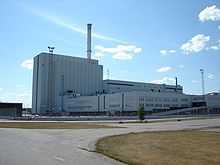Forsmark Nuclear Power Plant
| Forsmark Nuclear Power Plant | |
|---|---|
 Reactor 3 at Forsmark Nuclear Power Plant. | |
| Country | Sweden |
| Location | Forsmark |
| Coordinates | 60°24′12″N 18°10′0″E / 60.40333°N 18.16667°ECoordinates: 60°24′12″N 18°10′0″E / 60.40333°N 18.16667°E |
| Status | Operational |
| Commission date | 1980 |
| Operator(s) | Vattenfall |
| Nuclear power station | |
| Reactor type | Boiling water reactor |
| Power generation | |
| Units operational |
2 x 1010 MW 1 x 1190 MW |
| Annual generation | 22,300 GW·h |
|
Website www | |
Forsmark Nuclear Power Plant is a nuclear power plant in Forsmark, Sweden, and also the site of the Swedish Final repository for radioactive operational waste. It is operated by a subsidiary of Vattenfall.
Reactors
Forsmark NPP has three Boiling water reactors:
- F1 with an ABB Atom BWR 69 at 2928 MW thermal and 1010 MWe net was first connected to the grid on 5 June 1980, and commenced commercial operation on 10 December 1980. It has two turbo-alternators.
- F2 with an ABB Atom BWR 69 at 2928 MW thermal and 1010 MWe net was first grid connected on 15 December 1980 and commenced commercial operation on 7 July 1981. It is a twin of Unit 1.
- F3 with an ABB Atom BWR 75 at 3300 MW thermal and 1190 MWe net and was first grid connected on 3 March 1985 and commenced commercial operation on 21 August 1985. It is a later design with one turbo-alternator.
Other facilities
West of Forsmark Nuclear Power Plant, there is the static inverter of HVDC Fenno-Skan.
Waste disposal
Forsmark is the proposed site for the long-term burial of all spent fuel from Swedish nuclear power reactors, using the KBS-3 process. The new site will be located next to the already existing final repository for radioactive operational waste, but the two will not be connected with each other.
July 2006 incident
On 25 July 2006, one reactor was shut down after an electrical fault.[1][2] According to the Swedish Nuclear Power Inspection authority SKI, the incident was rated 2 on the International Nuclear Event Scale. Initially it was rated 1 since two generators remained online. But once it was discovered that all four generators could have failed due to the same fault, the event was upgraded to 2.
At the request of the Swedish Government, IAEA launched an OSART mission to Forsmark.
Lars-Olov Höglund, a former construction chief at Vattenfall, claimed it was the most serious nuclear incident in the world since the Chernobyl disaster and it was pure luck that prevented a meltdown.[3] Both the SKI and the safety chief of Forsmark power plant disagree with that opinion and state that the incident was serious but the description provided by Höglund was incorrect and there was no real risk of a meltdown.[4] Höglund has personally been involved in a legal dispute with Forsmark Nuclear powerplant for several years in connection with his private business.[5]
However, Kjell Olsson, a researcher at SKI, later stated in an informal discussion with school children that a meltdown technically could have developed from the incident.[6] The agency later stated that the failing safety system proved to be linked together in a delicate, extremely serious way.[7]
On March 14, 2011, Höglund commented that the Fukushima-disaster parallels the Forsmark incident, i.e. failing UPS system backup, and repeated his statement from 2007 that "only luck" prevented a meltdown at the Swedish plant.[8]
February 2007 shutdown
On February 3, two units at Forsmark were shut down to inspect a rubber seal in one of the safety systems. On Forsmark 1 this seal needed to be replaced, a job that would take approximately one month. Unit 2 was cleared by the regulator SKI and was free to restart.
In January an internal report made by a few employees at Forsmark who were concerned over a "degrading safety culture" was leaked to media who ran an extensive story on it. In the storm following the report the Forsmark CEO chose to resign. Forsmark was already under way to implement a 60-point program designed to improve safety culture, designed shortly after the event in July 2006.
Incursions by activists
In June 2010, Greenpeace activists invaded Forsmark to protest the then-plan to remove the government prohibition on building new nuclear power plants. In October 2012, 50 anti-nuclear activists used special ladders to scale security fences. Greenpeace said that its non-violent actions were protests against the continuing operation of these reactors, which it says are unsafe in European stress tests, and to emphasise that stress tests did nothing to prepare against threats from outside the plant. A report by the Swedish nuclear regulator said that "the current overall level of protection against sabotage is insufficient". Although Swedish nuclear power plants have security guards, the police are responsible for emergency response. The report criticised the level of cooperation between nuclear site staff and police in the case of sabotage or attack.[9]
See also
- International Nuclear Events Scale
- Nuclear safety
- Nuclear power
References
- ↑ Radio Sweden: Investigation into ”serious” fault at power station
- ↑ Web archive backup: European Atomic Forum: Forsmark incident rated as a Level 2...
- ↑ The Local: Nuclear plant 'could have gone into meltdown'
- ↑ Sveriges Television: SKI: Ingen risk för härdsmälta (Swedish)
- ↑ Web archive backup: DN Ledare: Strålande nyhet - inget har hänt (Swedish)
- ↑ , January 30, 2007.
- ↑ Web archive backup: SKI: SKI reviews the final disturbance analysis from Forsmark
- ↑ Dagens Nyheter, January 14, 2011 http://www.dn.se/nyheter/sverige/expert-det-som-hande-i-japans-reaktorer-kan-handa-ocksa-i-sverige
- ↑ "The antis attack!". Nuclear Engineering International. 5 April 2013.
External links
- Forsmark NPP home page (Swedish version).
- Technical data (Swedish version).
- Production history (Swedish version).
| ||||||||||||||||||||||||||||||||||||||||||||||||||||||||||||||||||
| ||||||||||||||||||||||||||||||||